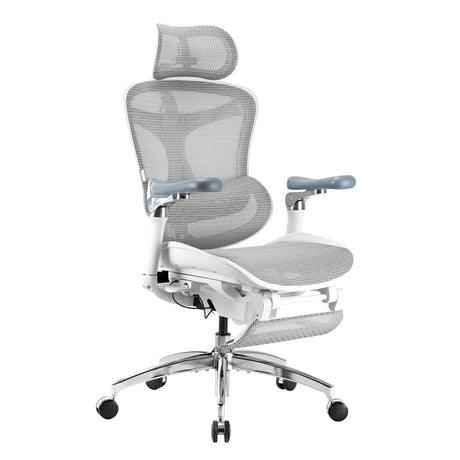Office chairs are an essential component of any workplace, providing comfort and support to employees who spend long hours seated at their desks. However, like any piece of furniture, office chairs can wear out over time, leading to discomfort and even injury if not replaced regularly. In this guide, we will explore the factors that determine the lifespan of office chairs, signs that indicate it's time for a replacement, and tips for choosing the right chair to promote workplace ergonomics.
Understanding the Lifespan of Office Chairs
The lifespan of an office chair can vary depending on several factors, including quality, usage, and maintenance. Generally, a high-quality office chair can last anywhere from 5 to 10 years with proper care. However, chairs that are used frequently or subjected to heavy loads may wear out more quickly.
Quality: The quality of materials and construction plays a significant role in determining how long an office chair will last. Chairs made from durable materials such as steel, aluminum, and high-quality plastics are likely to have a longer lifespan than those made from cheaper materials.
Usage: The frequency and duration of use also affect the lifespan of office chairs. Chairs that are used for several hours a day, five days a week, will experience more wear and tear than those used less frequently. Additionally, chairs that support heavier individuals or are subjected to constant movement may wear out more quickly.
Maintenance: Regular maintenance can help extend the lifespan of office chairs. This includes cleaning the chair regularly to remove dust and debris, tightening loose screws and bolts, and lubricating moving parts. Proper maintenance can prevent premature wear and ensure that the chair remains comfortable and functional for longer.
Signs It's Time for a Replacement
Even with proper care, office chairs will eventually wear out and need to be replaced. Here are some signs that indicate it's time for a new chair:
Visible Signs of Wear and Tear: Look for signs such as frayed or torn upholstery, loose or broken components, and visible damage to the frame or base of the chair. These issues not only affect the aesthetics of the chair but also compromise its structural integrity and comfort.
Persistent Discomfort: If employees complain of discomfort or pain while sitting in their chairs, it may be a sign that the chair is no longer providing adequate support. This could be due to worn-out padding, sagging seat cushions, or inadequate lumbar support.
Reduced Adjustability: Office chairs should be adjustable to accommodate a variety of body types and sitting preferences. If the chair's adjustments no longer work properly or are difficult to operate, it may be time for a replacement.
Squeaking or Grinding Sounds: Unusual noises such as squeaking, creaking, or grinding when moving or adjusting the chair could indicate worn-out or damaged components that need to be replaced.
Safety Concerns: If the chair wobbles or feels unstable when sat on, it poses a safety risk to the user. Chairs with damaged or weakened frames, bases, or casters should be replaced immediately to prevent accidents or injuries.
Choosing the Right Office Chair
When it comes time to replace office chairs, it's essential to choose options that promote workplace ergonomics and support the health and comfort of employees. Here are some factors to consider when selecting a new office chair:
Adjustable Features: Look for chairs with adjustable seat height, armrests, backrest angle, and lumbar support. These features allow users to customize the chair to their individual preferences and promote proper posture and alignment.
Lumbar Support: Proper lumbar support is crucial for preventing lower back pain and promoting spinal health. Choose chairs with built-in lumbar support or adjustable lumbar pads that provide adequate support to the lower back region.
Seat Padding and Cushioning: Opt for chairs with ample padding and cushioning to provide comfort during extended periods of sitting. High-density foam padding or memory foam seats are ideal for distributing weight evenly and reducing pressure points.
Breathable Materials: Choose chairs with breathable upholstery materials such as mesh or fabric to promote airflow and prevent overheating during long periods of sitting. Breathable materials help wick away moisture and keep users cool and comfortable throughout the day.
Weight Capacity: Consider the weight capacity of the chair to ensure it can safely support all users. Chairs with higher weight capacities are typically sturdier and more durable, making them suitable for a wider range of individuals.
Mobility: Select chairs with smooth-rolling casters that allow for easy movement and maneuverability around the office. Swivel capabilities are also essential for accessing different areas of the workstation without straining or twisting the body.
Warranty and Durability: Look for chairs with generous warranties and durable construction that can withstand daily use for years to come. Chairs with longer warranties often indicate higher quality and provide added peace of mind for both employers and employees.
Conclusion
Office chairs play a significant role in promoting workplace comfort, productivity, and ergonomics. Knowing when to replace office chairs and selecting the right options can help create a safe and supportive work environment for employees. By considering factors such as quality, usage, maintenance, and ergonomic features, employers can ensure that their workforce stays healthy, happy, and productive for years to come.



































